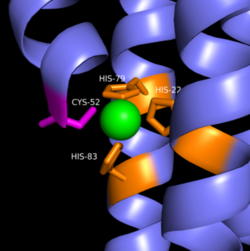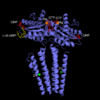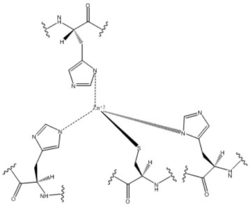Sandbox Reserved 1072
From Proteopedia
(Difference between revisions)
| Line 8: | Line 8: | ||
== Structural Overview == | == Structural Overview == | ||
| - | Enzyme DgcZ has been co-crystallized with Zinc conforming it to its inactivated conformation. The CZB domain is common to many bacterial lineages, appearing most commonly in bacterial chemoreceptors involved in chemotaxis. The second most common group of CZB domains is that of DgcZ homologs. [1]. The domain has an important role in signal transduction of bacteria[1]. 30 small bacterial proteins of family PRK0984 from differing strands of ''E. coli'' contain a CZB domain N-terminal to a GGDEF domain[1]. The GGEEF domain of DgcZ is common to this family of enzymes containing the GGDEF domain. ''E. coli'' DgcZ is a protein made of two domains each of which is a symmetric homodimer. The GGEEF domain is catalytic in that it contains the active sites used for cyclizing GTP into c-di-GMP. The CZB domain is used for ligand-mediated regulation of c-di-GMP production. Zinc binds as an allosteric inhibitor in coordination with four residues to shift the protein into an inactive conformation. | + | [[Image:Frnt vw whole molecule and ligs bound and labeled.png|100 px|left|thumb|Figure Legend]] |
| + | Enzyme DgcZ has been co-crystallized with Zinc conforming it to its inactivated conformation. The CZB domain is common to many bacterial lineages, appearing most commonly in bacterial chemoreceptors involved in chemotaxis. The second most common group of CZB domains is that of DgcZ homologs. [1]. The domain has an important role in signal transduction of bacteria[1]. 30 small bacterial proteins of family PRK0984 from differing strands of ''E. coli'' contain a CZB domain N-terminal to a GGDEF domain[1]. The GGEEF domain of DgcZ is common to this family of enzymes containing the GGDEF domain. ''E. coli'' DgcZ is a protein made of two domains each of which is a symmetric homodimer and exhibits <scene name='69/694239/C2_symmetry/6'>C2</scene> down its central axis. The GGEEF domain is catalytic in that it contains the active sites used for cyclizing GTP into c-di-GMP. The CZB domain is used for ligand-mediated regulation of c-di-GMP production. Zinc binds as an allosteric inhibitor in coordination with four residues to shift the protein into an inactive conformation. | ||
===Catalytic GGEEF Domain=== | ===Catalytic GGEEF Domain=== | ||
| - | The GGEEF domain of DgcZ is part of the GGDEF family of proteins that includes a conserved sequence, GG[DE][DE]F[2].The GGEEF domain is a homodimer consisting of a central five-stranded β-sheet surrounded by five α-helices. Each dimer contains an active half- | + | The <scene name='69/694239/Ggeef_domain_dgcz/2'>GGEEF</scene> domain of DgcZ is part of the GGDEF family of proteins that includes a conserved sequence, GG[DE][DE]F[2].The GGEEF domain is a homodimer consisting of a central five-stranded β-sheet surrounded by five α-helices. Each dimer contains an active <scene name='69/694239/Ggeef_domain_half_site_dgcz/1'>half-sites</scene> that, when combined together in a productive conformation, form the entire active site. Each half-site binds one GTP molecule. DgcZ binds the guanine base of GTP through hydrogen bonds to <scene name='69/694239/Gtp_guanine_bonds_asn_asp_dgcz/4'>Asn173 and Asp 182</scene>. The ribose portion of GTP is bound loosely and the alpha phosphate is not bound at all so that it is available for attack by the 3 prime hydroxyl group on another GTP. A <scene name='69/694239/Gtp_magnesium_cofactors_dgcz/1'>Magnesium ion</scene> (Mg<sup>2+</sup>) stabilizes the negative charges on the phosphate groups. When in the productive conformation, each GTP is held in close proximity with the α-phosphate groups overlapping C3 of the ribose. This conformation allows the α-phospate of one GTP to react with the alcohol group on C3 of the ribose of the other GTP, resulting in a cyclization of the two molecules into c-di-GMP. The ribose of each guanosine triphosphate, and subsequent product c-di-GMP riboses, are held only loosely by the enzyme, while the phosphate groups are not bound at all. |
===Mechanism of Action=== | ===Mechanism of Action=== | ||
| Line 23: | Line 24: | ||
===CZB Domain=== | ===CZB Domain=== | ||
| - | The CZB | + | The <scene name='69/694239/Zb_domain_residues_19-90/4'>CZB Domain</scene> is responsible for regulating the function of DgcZ. The CZB domain is defined as residues 19-90 on each monomer. The domain contains the allosteric binding site of the enzyme with cooperative binding. Four residues bind zinc with a high affinity even at 10<sup>-16M</sup> concentrations. Due to the tightness of Zinc binding, the enzyme has not yet been crystallized in the active conformation without the presence of Zinc metal inhibitor. |
[[Image:Zinc coordination DgcZ.png|250 px|left|thumb|Zn Coordination to amino acid residues on three of the four 𝝰 helices of DgcZ]] | [[Image:Zinc coordination DgcZ.png|250 px|left|thumb|Zn Coordination to amino acid residues on three of the four 𝝰 helices of DgcZ]] | ||
=== Zinc Binding Site === | === Zinc Binding Site === | ||
| - | Most cells possess efficient Zinc uptake systems, as Zinc is a reactive Lewis Acid. Zinc binds incredibly tightly to this enzyme at subfemtomolar concentrations. The Zinc co-purified with the protein.Zinc allosterically inhibits the activity of enzyme DgcZ through two allosteric binding sites located on the CZB domain. The inhibition prevents regulation of GGDEF domain function, the location of the active site. The CZB domain is folded into four anti-parallel α-helices as a 2-fold symmetric homodimer, with the N-terminus on the helix 𝝰4. The allosteric binding site includes amino acids, H22 of 𝝰1, C52 of 𝝰2, and H79 and H83 of 𝝰3, that span three of the four alpha helices of the CZB domain coordinating the Zinc residue in a tetrahedral fashion. Zahringer et al. mutated Cys52 to Ala through <span class="plainlinks">[http://www.chem.qmul.ac.uk/iubmb/enzyme/EC3/5/3/18.html site-directed mutagenesis]</span>, resulting in a lack of coordination on α2. The cysteine residue is not essential for Zinc binding, as Zinc still coordinates to the three His residues with the Cys52Ala mutation, but α2 is free to move and expose the Zinc binding pocket. This exposure was found to lower the protein's affinity for zinc, as the mutation of cysteine to alanine increased the activity of the DgcZ. Using EDTA, Zinc can be removed from the CZB domain. The zinc has higher affinity for EDTA than CZB when EDTA concentration is higher than the concentration of DgcZ. When not coordinated to zinc, the CZB domain adopts a conformation that straightens the 𝝰1 helix | + | Most cells possess efficient Zinc uptake systems, as Zinc is a reactive Lewis Acid. Zinc binds incredibly tightly to this enzyme at subfemtomolar concentrations. The Zinc co-purified with the protein.Zinc allosterically inhibits the activity of enzyme DgcZ through two allosteric binding sites located on the CZB domain. The inhibition prevents regulation of GGDEF domain function, the location of the active site. The CZB domain is folded into four anti-parallel α-helices as a 2-fold symmetric homodimer, with the N-terminus on the helix 𝝰4. The allosteric binding site includes a <scene name='69/694239/Zinc_binding_domain/4'>3His/1Cys</scene> motif that uses amino acids, H22 of 𝝰1, C52 of 𝝰2, and H79 and H83 of 𝝰3, that span three of the four alpha helices of the CZB domain coordinating the Zinc residue in a tetrahedral fashion. Zahringer et al. mutated Cys52 to Ala through <span class="plainlinks">[http://www.chem.qmul.ac.uk/iubmb/enzyme/EC3/5/3/18.html site-directed mutagenesis]</span>, resulting in a lack of coordination on α2. The cysteine residue is not essential for Zinc binding, as Zinc still coordinates to the three His residues with the Cys52Ala mutation, but α2 is free to move and expose the Zinc binding pocket. This exposure was found to lower the protein's affinity for zinc, as the mutation of cysteine to alanine increased the activity of the DgcZ. Using EDTA, Zinc can be removed from the CZB domain. The zinc has higher affinity for EDTA than CZB when EDTA concentration is higher than the concentration of DgcZ. When not coordinated to zinc, the CZB domain adopts a conformation that straightens the <scene name='69/694239/Czbd_with_helices_labeled/2'>𝝰1 helix</scene>, shifting <scene name='69/694239/Hydrophobicity_int_residues/3'>hydrophobic residues</scene> on the α-helices into the center and the GGEEF domain into its productive conformation, increasing activity of DgcZ. Activity increases without Zinc due to activation of poly-GlcNAc production and biofilm formation, and maximal cyclic di-GMP production. |
| + | |||
| + | === Other Ligands === | ||
| + | c-di-GMP and GTP bind <scene name='69/694239/Flldgczwithc-di_and_allosteric/1'>allosterically</scene> although the function of this binding is unknown. Very weak product inhibition was observed when c-di-GMP bound allosterically but the inhibition was so weak, it is possible the c-di-GMP actually interacts with another as of yet unknown molecule at that site. | ||
== References == | == References == | ||
<Jenny Draper, K. Karplus, K. Ottemann. Identification of a Chemoreceptor Zinc-Binding Domain Common to Cytoplasmic Bacterial Chemoreceptors. Journal of Bacteriology. Vol. 193, No. 17. 4338-4345. (2011).> | <Jenny Draper, K. Karplus, K. Ottemann. Identification of a Chemoreceptor Zinc-Binding Domain Common to Cytoplasmic Bacterial Chemoreceptors. Journal of Bacteriology. Vol. 193, No. 17. 4338-4345. (2011).> | ||
<Carmen Chan, R. Paul, D. Samoray, N. Amiot, B. Giese, U. Jenal, T. Schirmer. Structural basis of activity and allosteric control of diguanylate cyclases. PNAS. Vol 101. No. 49 17084-17089. (2004).> | <Carmen Chan, R. Paul, D. Samoray, N. Amiot, B. Giese, U. Jenal, T. Schirmer. Structural basis of activity and allosteric control of diguanylate cyclases. PNAS. Vol 101. No. 49 17084-17089. (2004).> | ||
| - | |||
| - | |||
| - | == Biological Function == | ||
| - | [[Image:Frnt vw whole molecule and ligs bound and labeled.png|100 px|left|thumb|Figure Legend]] | ||
| - | |||
| - | |||
| - | == Structural Overview == | ||
| - | Diguanylate Cyclase is a homodimer that exhibits <scene name='69/694239/C2_symmetry/6'>C2</scene> symmetry down its vertical axis. | ||
| - | ===GGEEF Domain=== | ||
| - | The <scene name='69/694239/Ggeef_domain_dgcz/2'>GGEEF</scene> Domain of Diguanylate Cyclase is the active site of the protein and has two amino acid sequences of GGEEF which allows for binding of two GTP molecules. The Active site can be divided up into two enzymatic <scene name='69/694239/Ggeef_domain_half_site_dgcz/1'>half-sites</scene>, each with a GGEEF domain for binding a single GTP molecule. DgcZ binds the guanine base of GTP through hydrogen bonds to <scene name='69/694239/Gtp_guanine_bonds_asn_asp_dgcz/4'>Asn173 and Asp 182</scene>. The ribose portion of GTP is bound loosely and the alpha phosphate is not bound at all so that it is available for attack by the 3 prime hydroxyl group on another GTP. A <scene name='69/694239/Gtp_magnesium_cofactors_dgcz/1'>Magnesium ion</scene> acts as a cofactor for each half-site, helping to stabilize the negative charges on the phosphates of GTP. | ||
| - | ===Zinc Binding Domain=== | ||
| - | Officially defined as residues 19-90. | ||
| - | ====3His/1Cys Motif==== | ||
| - | The <scene name='69/694239/Zinc_binding_domain/4'>3His/1Cys</scene> Motif | ||
| - | [[Image:Zinc_coordinated_chemdraw.jpg]] | ||
| - | == Mechanism of Action == | ||
| - | <scene name='69/694239/Hydrophobicity_int_residues/3'>Hydrophobic residues</scene> on the alpha helices of the zinc binding domain participate in van der waals interactions that induce a conformational change in the protein when zinc binds. When Zinc binds, the <scene name='69/694239/Czbd_with_helices_labeled/2'>𝝰1 helix</scene> becomes straightened, burying nonpolar side-chain residues, influencing activity of DgcZ | ||
| - | |||
| - | == Zinc Ligand(s) == | ||
| - | The two <scene name='69/694239/Zb_domain_residues_19-90/4'>Zinc binding domains</scene> of Diguanylate Cyclase bind a single zinc ion each, for a total of two zinc ions. The domain constitutes residues 19-90 on each monomer. | ||
| - | |||
| - | == Other Ligands == | ||
| - | c-di-GMP and GTP bind <scene name='69/694239/Flldgczwithc-di_and_allosteric/1'>allosterically</scene> although the function of this binding is unknown. Very weak product inhibition was observed when c-di-GMP bound allosterically but the inhibition was so weak, it is possible the c-di-GMP actually interacts with another as of yet unknown molecule at that site. | ||
| - | |||
</StructureSection> | </StructureSection> | ||
== References == | == References == | ||
<references/> | <references/> | ||
Revision as of 17:44, 31 March 2017
| This Sandbox is Reserved from 02/09/2015, through 05/31/2016 for use in the course "CH462: Biochemistry 2" taught by Geoffrey C. Hoops at the Butler University. This reservation includes Sandbox Reserved 1051 through Sandbox Reserved 1080. |
To get started:
More help: Help:Editing |
Diguanylate Cyclase DgcZ from Escherichia coli
| |||||||||||



